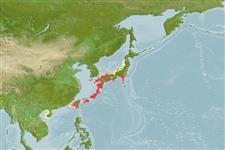>
Acropomatiformes (Oceanic basses) >
Creediidae (Sandburrowers)
Etymology: Creedia: Greek, kreesi, kreas = somebody that receives or keeps flesh (Ref. 45335); bilineata: Named in reference to the two stripes on the body..
Environment: milieu / climate zone / depth range / distribution range
Écologie
marin démersal; profondeur 3 - 5 m (Ref. 12706). Subtropical
Northwest Pacific: Japan.
Taille / Poids / Âge
Maturity: Lm ? range ? - ? cm
Max length : 3.2 cm SL mâle / non sexé; (Ref. 12706)
Description synthétique
Clés d'identification | Morphologie | Morphométrie
Rayons mous dorsaux (Total) : 15 - 16; Rayons mous anaux: 17 - 18; Vertèbres: 42. Epurals 2; body with two yellowish brown stripes in life (Ref. 12706).
Found on shallow sandy bottom (Ref. 12706). Observed to abruptly rush out of the sand and immediately dive into nearby when disturbed (Ref. 12706).
Life cycle and mating behavior
Maturities | Reproduction | Spawnings | Egg(s) | Fecundities | Larves
Shimada, K. and T. Yoshino, 1987. A new creediid fish Creedia bilineatus from the Yaeyama Islands, Japan. Jap. J. Ichthyol. 34(2):123-127. (Ref. 12706)
Statut dans la liste rouge de l'IUCN (Ref. 130435)
Menace pour l'homme
Harmless
Utilisations par l'homme
Outils
Articles particuliers
Télécharger en XML
Sources Internet
Estimates based on models
Preferred temperature (Ref.
123201): 20.5 - 26.3, mean 23.5 °C (based on 109 cells).
Phylogenetic diversity index (Ref.
82804): PD
50 = 0.5625 [Uniqueness, from 0.5 = low to 2.0 = high].
Bayesian length-weight: a=0.00102 (0.00046 - 0.00225), b=3.06 (2.88 - 3.24), in cm total length, based on all LWR estimates for this body shape (Ref.
93245).
Niveau trophique (Ref.
69278): 3.1 ±0.4 se; based on size and trophs of closest relatives
Fishing Vulnerability (Ref.
59153): Low vulnerability (10 of 100).
